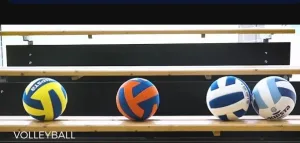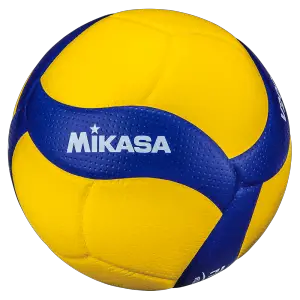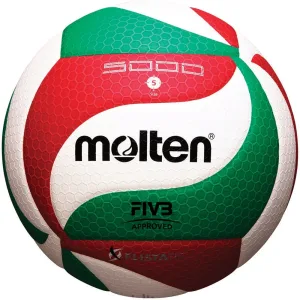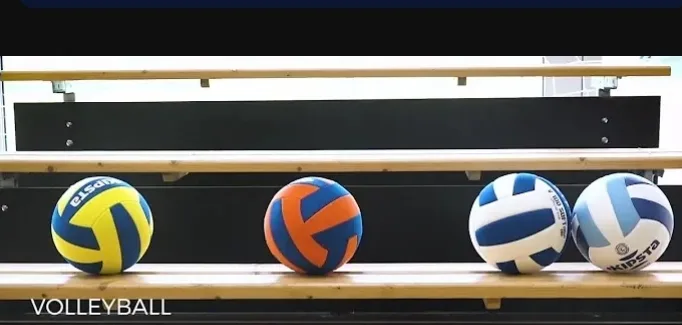Here we want to dive into volleyball ball characteristics, brands, sizes, weight, material, maintenance, history, and the best volleyball balls in 2025 that is available on the market.
A volleyball ball is used for indoor volleyball, beach volleyball, and other variations of the sport.
It is a spherical ball, typically made up of eighteen nearly rectangular panels constructed from synthetic or genuine leather.
These panels are arranged into six identical sections, each containing three panels, which are then wrapped around a bladder to form the complete volleyball.
A valve allows for the adjustment of the internal air pressure. In 2008, deviating from traditional designs, the FIVB adopted a new Mikasa ball with dimples and only eight panels for a softer touch and more accurate flight as its official indoor ball.
Volleyball ball Characteristics

Indoor volleyballs are designed specifically for indoor play, while beach volleyballs are tailored for beach games.
Indoor volleyball: These can be either solid white or the brightest shade of yellow. They come in two types: a youth version that is slightly smaller and lighter, and a heavier “medicine ball” type used by setters to build finger strength.
Beach volleyball: These are slightly larger than indoor balls, with a coarser exterior texture and lower internal pressure. They are available in vibrant colours or solid white. The earliest volleyballs were made using leather panels over a rubber carcass.
Volleyball ball brands
There are several volleyball ball brands that manufacture competitive volleyballs. They are:
- Tachikara
- Molten
- Allsix
- Copaya
- Wilson
- Baden Sports
- Mikasa
- Mizuno
- Nike
- Spalding
- Beta
- USSPT
- Gala (produced in the Czech Republic)
Most of these brands also offer more affordable versions designed for recreational, non-competitive play.
Pro volleyball ball Brands
Mikasa produces the official balls for the Fédération Internationale de Volleyball (FIVB) and the CEV (European Volleyball Confederation) for both beach volleyball and indoor volleyball.
Apply for Government Grants: Up to 250,000 available
Molten manufactures the official ball for USA volleyball and NCAA indoor volleyball.
Wilson creates the official ball for the Association of Volleyball Professionals (AVP) and NCAA beach volleyball.
Professional volleyball ball
Professional volleyball balls are the balls used by the volleyball professional body, which are:
- Mikasa volleyball balls: these are volleyball balls used by the Fédération Internationale de Volleyball (FIVB) and the CEV (European Volleyball Confederation) for both beach volleyball and indoor volleyball.
- Molten: these are the official balls for USA volleyball and NCAA indoor volleyball.
- Wilson: These volleyball balls are official balls for the Association of Volleyball Professionals (AVP) and NCAA beach volleyball.
Volleyball Size
The official size of a volleyball is 65–67 centimeters in circumference. Smaller balls are generally more suitable for women and youth players, while larger balls are used in men’s volleyball.
Apply for Government Grants: Up to 250,000 available
The choice of size can also depend on personal preference; some people prefer a larger ball for better grip, while others prefer a smaller one for greater maneuverability.
See Also:
- Discover Best Volleyball Nets in 2024 – Best Choices
- Home Volleyball Training Equipment
- Best Volleyball shoes, Review of different Volleyball shoes 2024
Weight and Material
Volleyballs are typically made of synthetic leather, microfiber, or PVC. Each material offers different benefits in terms of durability and feel.
The weight of a volleyball ball ranges from 9 to 10 ounces (260 to 280 grams), and having the correct weight is crucial for accurate and controlled play.
Inflation Pressure
The optimal pressure for a volleyball is between 4.3 and 4.6 psi. A properly inflated ball ensures better control and accuracy when passing and serving.
Level of Competition
Beginner players may prefer softer, more affordable balls, while advanced players often opt for higher-quality balls that offer better performance. Competition balls usually meet stricter standards and provide a superior feel and control.
Care and maintenance
To keep your volleyball in top condition, clean it regularly and store it in a cool, dry place. Avoid exposing the ball to direct sunlight or humid conditions, as these can reduce its lifespan.
Best volleyball ball
You need to know which volleyball you want to play, whether you want to play indoor or beach volleyball. To determine the best volleyball suitable for the sport and you, here are a few top-rated options:
Indoor Volleyballs

Mikasa V200W: The Mikasa V200W is widely considered the best volleyball ball for indoor play because of its excellent grip, durability, and consistent performance, and it is the official ball of the FIVB.
Molten FLISTATEC V5M5000: this is the second-best indoor volleyball ball that’s known for its stability and precision. It is often used in professional leagues and competitions.

Tachikara Sensi-Tec Composite SV-5WSC is the 3rd-best indoor volleyball ball on the market that’s popular in schools and colleges for its soft touch and durability.
Beach Volleyballs
Mikasa VLS300: The Mikasa VLS300 is the top-choice ball for beach volleyball and the official ball of the FIVB for beach volleyball, known for its water resistance, durability, and consistent performance.
Wilson AVP Official Game Ball: The second-best ball for beach volleyball that’s used in the AVP tour, it offers great control and durability in outdoor conditions.
Spalding King of the Beach is the third-best ball for beach volleyball on this list. With its good durability and performance in beach conditions, it is often used in recreational and competitive play.
Each of these balls mentioned above has a great reputation for quality and performance in their respective environments.
Apply for Government Grants: Up to 250,000 available
See Also: 5 Best Budget Volleyball Shoes
Volleyball ball history
The first volleyball ball, developed in 1895 by William G. Morgan, the inventor of volleyball, was made using a basketball bladder.
Conclusion
Choosing the right volleyball is essential for enjoying the sport to the fullest. Take the time to consider these important factors before making a purchase. With the right volleyball ball, you can enhance both your game and your overall experience on the court.
